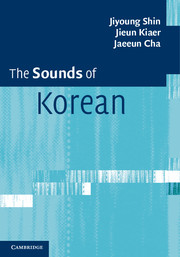Book contents
- Frontmatter
- Contents
- Figures
- Tables
- Preface
- Notational conventions
- 1 Characteristics of the Korean language
- 2 Production of sounds
- 3 Basic concepts of phonology
- 4 Consonants
- 5 Vowels
- 6 Frequency trends of Korean sounds
- 7 Prosody
- 8 Phonological rules of Korean (I)
- 9 Phonological rules of Korean (II)
- 10 Loanword phonology
- Notes
- Bibliography
- Index
6 - Frequency trends of Korean sounds
Published online by Cambridge University Press: 05 November 2012
- Frontmatter
- Contents
- Figures
- Tables
- Preface
- Notational conventions
- 1 Characteristics of the Korean language
- 2 Production of sounds
- 3 Basic concepts of phonology
- 4 Consonants
- 5 Vowels
- 6 Frequency trends of Korean sounds
- 7 Prosody
- 8 Phonological rules of Korean (I)
- 9 Phonological rules of Korean (II)
- 10 Loanword phonology
- Notes
- Bibliography
- Index
Summary
In Chapters 4 and 5, we have discussed the phonetic and phonological characteristics of consonants and vowels in Korean. However, not all of the sounds which exist are found frequently in Korean, and some are used more often than others. In this chapter, we would like to explore the frequency of sounds in Korean to find out which sounds are frequently used and which are used less. We will try to find the answers by looking at dictionary data and spontaneous speech data. In addition, we will compare the frequency of sounds in Korean with that of sounds in English.
There are 19 consonants and 7 monophthongs in Korean, along with 10 diphthongs made from 7 monophthongs and 3 glides. Therefore, 36 sounds exist in total in the Korean sounds inventory. In the previous chapter, we considered a diphthong as a combination of a monophthong and a glide. This view can provide a better explanation because it doesn’t increase the number of phonemes unnecessarily. In addition, this can capture the phonetic similarity between the corresponding monophthong and the glide and hence increase explanatory adequacy in accounting for the behaviours of speech sounds.
- Type
- Chapter
- Information
- The Sounds of Korean , pp. 118 - 150Publisher: Cambridge University PressPrint publication year: 2012



